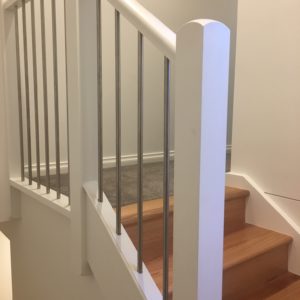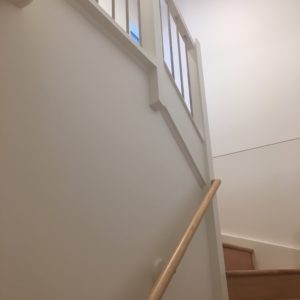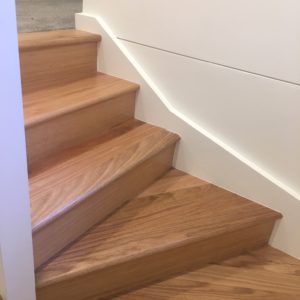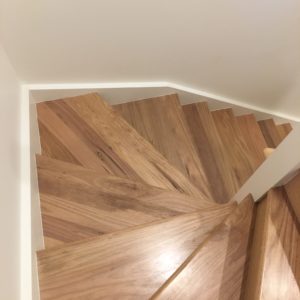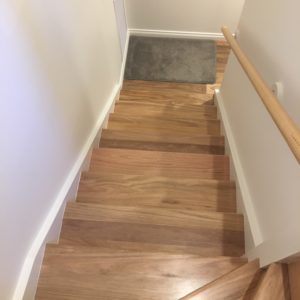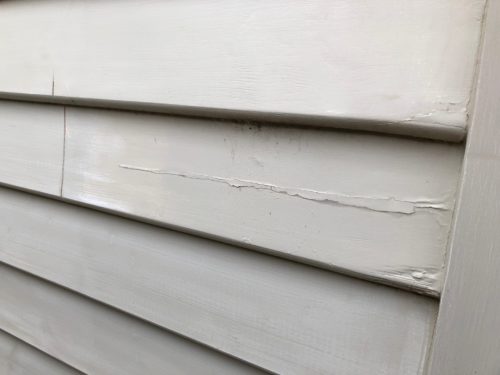Contents
Scope of work
The newly laid engineered flooring throughout the entire ground floor of the house already came with a prefinished look, meaning it already had a clear satin finish applied to the face. Therefore the only area requiring a timber varnish of a clear polyurethane coating was the staircase and the original plans were to have the stair treads and rises, stringers, posts and handrails all stained and varnished to match the engineered flooring which was Spotted Gum. The staircase manufacturer built the majority of the stairs out of hardwood timber which was Tasmanian Oak and the stringers were made out of softwood which was Pine.
Colour Matching the flooring and staircase with stains
We need to add colour to a staircase with two different timbers in order to try to match it as close to the Spotted Gum flooring. What do I mean by colour? Simply that we need to find a stain that when applied to the stairs will look similar in colour to the flooring which would leave the naked eye thinking that the same timber was used throughout. Here lies the challenge with having 2 different types of timber built into the staircase. How are they different? Primarily one is a hardwood, slightly darker in colour and more dense and the other being a softwood, is somewhat lighter and porous. If I was to apply the same colour stain to both timbers at the same time, the hardwood will absorb the stain differently to the softwood and when dried, it would definitely highlight the contrast between the two different timbers.
So, what’s the answer?
Put simply, both the Tasmanian Oak hardwood and the Pine softwood would need to be individually colour matched with the Spotted Gum flooring. That means that there would need to be two different colour stains applied to the staircase to match it with the flooring. That is a lot of work to try and find a combination of stains that would ultimately all blend in as one. In the end, I suggested to the clients that the stringers could be painted in the same colour as all the skirting throughout the house to which they agreed. This practice of painting stringers and leaving the stairs to be coated with a stain or timber varnish is in many instances always the norm.
What was decided?
My clients did still request that their main priority was that the stair treads and rises be stained and varnished as well as the posts and handrails, although they were happy to paint them if the combination of the stain and wall colours did not look aesthetically pleasing. One thing to consider when looking at any new staircase is to understand that even though the same type of timber is used, in this case Tasmanian Oak, it is not always from the same tree. What that means is that different pieces of Tasmanian Oak timber was sourced from different mills to make this particular staircase. What results is a staircase that will have timbers with some knots, different grains and different shades or depths colour which all combines to produce a unique finish.
What’s the process of finding the right stain?
To start with, we needed to look at the Spotted Gum flooring and assess what dominant colours come through the timber and we identified a combination of walnut, teak and oak. We then needed an off-cut of Tasmanian Oak timber from the staircase so we could apply the various stains onto it. Unfortunately the installer didn’t leave any behind, which meant that we needed to buy a small piece of Tasmanian Oak timber from the hardware store. Below is a picture of what I call the ‘Colour Tree‘ because on it I applied and labelled the various stains so as to provide choices in colour that would best match the Spotted Gum flooring.

What colour stain was chosen?
After leaving the ‘Colour Tree’ with the clients for a couple of days, it was decided that the best colour that suits the Spotted Gum flooring was a combination of Feast Watson Oak and a small amount of Feast Watson Teak Brown. The end ratio was Oak 4:1 Teak and that meant we were ready to begin coating the stairs.
Where to start applying timber varnish?
Because the clients were flexible in their view of whether to stain or paint the posts and handrails, that is exactly where we started. We began with staining the main posts of the staircase and the upper handrail. Once the stain was applied and left to dry, it quickly became apparent that it just did not suit the staircase and stairwell because it just did not flow or blend into any other surfaces as they were all painted in particular the stringers. It was decided that the posts and handrail would all be painted to suit the woodwork colour which was Dulux Antique USA.
We then proceeded to continue with the stair treads and rises. Having prepared them thoroughly with sanding to remove any dirt and scuff marks and vacuuming to remove the dust, the one coat of stain and three coats of timber varnish using Cabots CFP flooring polyurethane were applied. Between each coat of polyurethane, the treads and rises where lightly sanded to remove any runs and timber fur. Below are pictures of the staircase at preparation and final finish.
Conclusion
What started as a project where the entire staircase needed to be coated in polyurethane, resulted in a very different outcome. It was a process of open communication with the clients on the pro’s and con’s of undertaking various steps with colour matching different timbers, to combining a mixture of stains to suit the engineered flooring and to adjusting colour schemes because of aesthetics or better said ‘it just didn’t feel right’. Above all, having to modify the original scope of works is required at times to get a better result.




